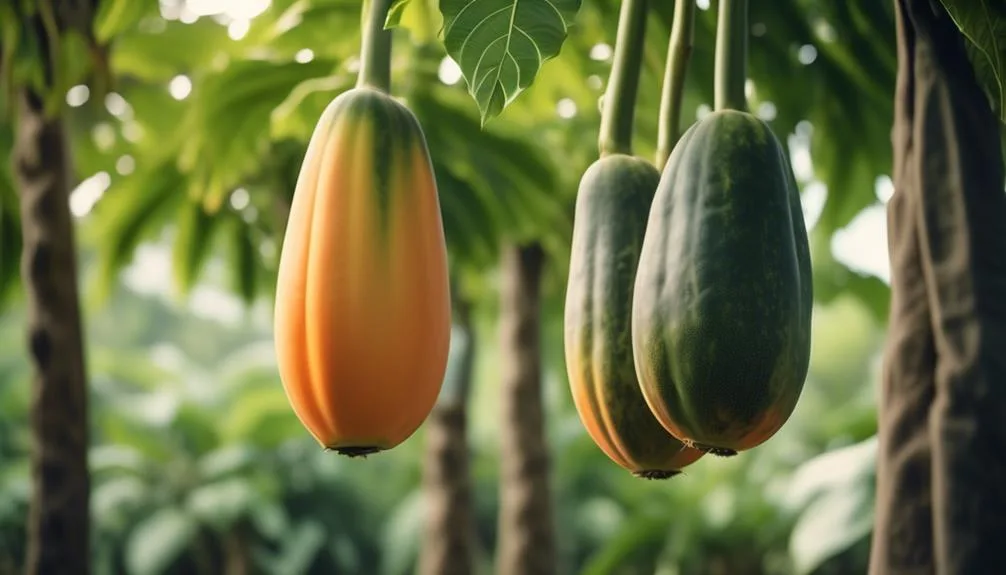Papaya trees come in various shapes, sizes, and colors, making it intriguing to learn about different varieties. Whether you're a gardener or just curious, identifying these tropical trees can be fascinating.
As you delve into the world of papaya trees, you'll uncover the beauty of nature and the diversity of horticulture.
Key Takeaways
- Papaya trees come in various shapes, sizes, and colors, with each variety offering unique flavors, sizes, and characteristics.
- The Red Lady papaya is prized for its sweet, vibrant orange flesh, while the Maradol papaya is known for its large size and delicious taste.
- Papaya tree leaves have distinct features such as a large, deeply lobed shape, smooth glossy texture, and a spiral arrangement at the apex of the trunk.
- Papaya fruits are elongated and can grow up to 20 inches in length, starting green and ripening to yellow or orange, with some varieties having red or pink hues when ripe.
Papaya Tree Varieties Overview
Discover the diverse range of papaya tree varieties, each offering unique flavors, sizes, and characteristics to suit various preferences and growing conditions.
When it comes to papaya tree cultivation, it's essential to consider the specific variety you want to grow. The Red Lady papaya, for instance, is prized for its sweet, vibrant orange flesh and is a popular choice for home gardens.
The Maradol papaya, on the other hand, is known for its large size and delicious taste, making it ideal for fresh consumption and various culinary uses.
Understanding the different papaya tree varieties allows you to select the one that best fits your needs, whether it's for personal enjoyment, commercial production, or utilizing the tree's fruit for its numerous health benefits and culinary uses.
Identifying Papaya Tree Leaves
To identify papaya tree leaves, observe the distinct features such as the large, deeply lobed shape and the smooth, glossy texture, which are characteristic of this tropical fruit tree. Papaya tree leaves are typically large, ranging from 20 to 40 centimeters in diameter, and are deeply lobed with 7 distinct lobes. The leaves are clustered at the top of the trunk and have a glossy texture, making them easy to identify. The growth patterns of papaya tree leaves include a spiral arrangement at the apex of the trunk, giving the tree a unique and attractive appearance. Here's a table to help you better understand the characteristics of papaya tree leaves:
| Leaf Characteristics | Growth Patterns |
|---|---|
| Large and deeply lobed | Spiral arrangement |
| Smooth and glossy texture | Clustered at the top of the trunk |
Recognizing Papaya Tree Fruits
With its large and deeply lobed leaves, the papaya tree sets the stage for its distinctive, delicious fruits, which are a defining feature of this tropical plant.
Here's how to recognize papaya tree fruits:
- Fruit characteristics: Papaya fruits are typically elongated and can grow up to 20 inches in length. They start green and then ripen to yellow or orange, with some varieties having red or pink hues. When ripe, the skin becomes soft and yields to gentle pressure.
- Growth patterns: Papaya trees bear fruits directly from the trunk rather than from branches. The fruits grow in clusters near the top of the tree and develop from the tree's crown, with mature trees producing multiple fruits simultaneously.
These unique fruit characteristics and growth patterns make papaya tree fruits easily recognizable.
Understanding Papaya Tree Size and Shape
Amidst a tropical backdrop, papaya trees stand with their slender trunks and broad, deeply-lobed leaves, contributing to their distinct size and shape. Papaya tree growth is rapid, reaching heights of 10-12 feet within a year and continuing to grow up to 30 feet.
The trunk is soft and not very sturdy, with the tree forming a compact and rounded shape. Pruning is essential to maintain the desired size and shape of the papaya tree. Regular pruning helps to control the height and encourages lateral growth, resulting in a bushier appearance.
When pruning, it's important to remove dead or diseased branches and to thin out the canopy to allow sunlight to penetrate and promote overall tree health. By implementing proper papaya tree pruning techniques, you can ensure a well-maintained and productive tree.
Distinguishing Papaya Tree Flowers
When distinguishing papaya tree flowers, observe the cluster of white, cream, or yellow blossoms that emerge from the leaf axils, typically near the top of the trunk. These flowers are essential in identifying different papaya tree varieties. Here's what to look for:
- Flower Color: Papaya tree flowers can be white, cream, or yellow, with variations and combinations of these colors.
- Flower Morphology: The flowers have five petals and are typically fragrant, with a waxy texture. They're either male, female, or hermaphroditic, and their size and shape can vary between different papaya tree varieties.
- Blooming Pattern: Papaya tree flowers can bloom year-round, but there may be peak blooming seasons depending on the variety and environmental conditions.
- Fruit Set: Observing the flowers can give an indication of the potential fruit yield, as different varieties may have varying rates of successful fruit set.
Conclusion
Incorporating these key characteristics into your papaya tree knowledge will allow you to confidently identify different varieties based on their leaves, fruits, size, shape, and flowers.
Whether it's the Solo, Tainung, or Maradol variety, you'll now be able to recognize them all with ease.
Happy papaya tree spotting!

